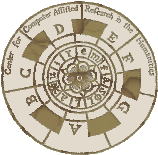Musical Information
Handouts
|

|
- Informal Registration Form
for the class find out what you know and what you are intersted in.
- Rosetta Stone of Musical Data --
A set of musical data encodings all describing the same
short melodic example.
- MuseData Examples -- graphical notation and underlying Stage 1/2 MuseData as well as examples of
ifiles which are an intermediate form of MuseData for printing.
- MuseData File Processing Chart --
Basic description of MuseData files and how they are processed.
- MuseData Workflow for online publishing
-- Description of the programs used to convert Stage 2 data into
publishable online scores.
- MuseData Source File Description --
A description of MuseData Stage2 files which are the primary encoding format
for music at CCARH. Data in this format
is available online at MuseData.org.
- MuseData autoset program -- Implementation data description
for the MuseData program called autoset which converts MuseData stage2 files into
ifiles which are used to print music.
- Musedata Ifiles Description --
Intermediate files which a generated by the autoset MuseData
program and processed by several other programs such as mskpage (make
score page). This data format is intermediate between Stage 2
MuseData files and the final graphic musical output. Ifiles encode the
two-dimensional position of musical elements on a staff in either linear
mode or page mode (linear mode with line breaks).
- MusicXML encoding of the first four bars
of Mozart's piano sonata K457, Eleanor Selfridge-Field.
- SCORE 4.0 Music Data Entry Reference Manual --
complete guide for the five-stage SCORE data entry process.
- SCORE User Input Exercises
-- good exercises for starting to learn the SCORE data-entry system which
is used in the SCORE Input Basics lab.
- SCORE Exercise #2 --
Five short musical examples which can be typeset using only the SCORE
five-stage input process. There are a few tricky cases which have to be
done by editing note parameters to get the final output.
This handout goes with the second SCORE lab.
- SCORE Code 1 Parameters (Notes)
-- Visual reference sheet for the parameters which affect the graphical
display of a musical note in SCORE.
- SCORE Code 5 Parameters (Slurs)
-- Visual reference sheet for the parameters which affect the graphical
display of ties/slurs in SCORE.
- SCORE 4.0 Text Commands
- SCORE Parameters From an I-File Point of View
Description of SCORE item parameters and how they relate to MuseData I-File
parameters.
- MuseData to SCORE Conversion Example
Examples of the output and intermediate files in the process of converting
MuseData files into SCORE files. Source code for programs mentioned
in the handout:
[
autoscr |
autoset |
mskpage |
paging |
pskpage |
scorecon ]
- MIDI Communication Protocol -- Description
of MIDI communication protocol.
- binasc -- command-line program for displaying
binary files as ASCII numbers.
- Outline of the Standard MIDI File Structure --
Brief description of the Standard MIDI File data format.
- MIDI File Variable Length Values -- The specification for
variable length values (VLV) which are used to store MIDI delta times
in Standard MIDI files.
- General MIDI Instruments -- A list of
standardized instruments in the General MIDI specification.
- List of General MIDI Continuous Controllers.
- Byte Table -- A list of
all numbers in a byte and their various meanings in MIDI and ASCII.
- A Roadmap of the MIDI Byte -- A list of
all numbers in a byte and their various meanings in MIDI and ASCII. (PDF Reference Chart Version)
- twinklehex.pdf -- An example MIDI file
in ASCII hexadecimal format which contains the melody
Twinkle, Twinkle, Little Star [twinkle.mid].
- Kern information -- basic melodic
example of music in the Humdrum **kern data format.
- Humdrum **koto specification -- example
of how to encode non-western music in Humdrum files.
Revised: 9 Mar 2005
|